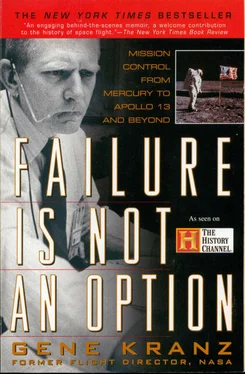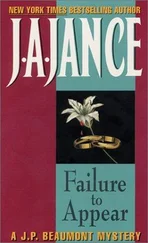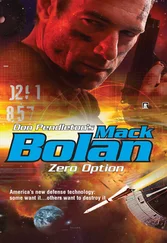Scott and Irwin left on the Moon a plaque with the names of the three Russian astronauts, adding theirs to the honor roll of others—the Apollo 1 astronauts, the Soyuz 1 astronaut, and all the rest—who had lost their lives in the quest to explore the universe.
Windler launched the crew off the surface, rendezvoused, and then docked before handing over to Lunney on the fifty-first revolution. The crew was on the timeline and there were few apparent problems for Lunney, the kind of shift you pray for. This was a time to catch a breath, clean up the spacecraft problems, and get ready for the trip home. The crew had been awake for sixteen hours, performing physically demanding work, which was followed by the intensity of a lunar liftoff, rendezvous, and docking. The principal activity of Lunney’s shift was to jettison the lunar module and then get the crew to sleep.
Lunney’s problems started during the crew’s seventeenth hour awake. As a precaution for a loss of pressure during the LM jettison, the crew donned helmets and gloves and performed a suit pressure check. Then, to make sure there were no leaks in the hatch seal, the crew gradually depressurized the tunnel connecting the command module (CM) to the lunar module (LM) while the CM pressure was monitored for any decrease.
The initial suit integrity check failed due to a pressure suit leak at the fitting where water is fed to the liquid-cooled garment. After both suits were plugged, the suit integrity test was passed satisfactorily. After a brief verbal update on the depress sequence, the crew continued the preparation for the jettison.
During communications with Mission Control, Scott commented on the difference between the pressures in the command module and in the tunnel. “The tunnel pressure was at 2.7 a while ago,” he said, “and now it is down to 2.0.” Scott was reading the pressure from a small gauge in the tunnel, one normally used by the crew prior to opening the hatch, or when separating the spacecraft. Lunney’s hairs stood on end; many things must be right in space, and cabin pressure is at the top of the list. Lunney, now concerned about the decrease in pressure, ascribed it to a possible hatch seal leak. Given the earlier problems in the suit integrity check, he scrubbed the LM jettison. The crew backed out of the configuration, removed the hatch, and visually inspected the seals. They were then given precise instructions for another command module pressure check.
While the astronauts were performing the pressure checks I was in the orbital science back room talking to the controllers and scientists prior to coming on shift. Dick Koos, my Apollo 11 SimSup, now operating in a new role as an experiments engineer, motioned me to his console. As I leaned over he said, “Lunney’s having a hell of a problem getting the crew through the separation checklist. Something is out of whack.” I thanked Dick for his heads-up and quickly moved to the control room.
At acquisition of the CSM telemetry and voice communications on orbit fifty-three, Scott had unexpectedly vented the tunnel. Lunney, absolutely unruffled, told the crew to pump the tunnel back up. Glynn was getting frustrated; he knew something was wrong and forcefully reminded his controllers to call out every step of the crew’s procedures as they were performed. He wanted his team’s eyeballs in the cockpit with the crew.
Lunney continued with his usual superb, unbridled confidence, his voice never exposing any emotion, so his people never sensed his frustration. Now satisfied with the suit and cabin-pressure check, Glynn gave the “Go for jettison.” I was spooked just listening. Even in the most bloodcurdling simulation I had never seen the crew and ground so out of phase.
The LM jettison delay changed the orbit geometry for separation. Approaching maneuver time, Scott remarked that the planned maneuver took the CSM toward the LM. After an intense discussion with his team, Lunney scrubbed the maneuver. Stoval, the FIDO, quickly planned a new one. “Glynn, have the crew stay in front of the LM, point at it, and thrust away for two-feet-per-second velocity. This will give us enough clearance.”
When Scott executed the maneuver, Lunney showed his only emotion, inscribing in the log, “Hurrah—I felt I was in one of those bad dreams where you can’t wake up and you can’t get anything to go right!” Even though I had come in only for the last two hours, I had the same creepy feeling. At no time on the console had I ever felt so apprehensive.
Throughout the pressure check and maneuver fiasco, Dr. Chuck Berry had been standing and talking to Dr. Gilruth and Kraft at the console behind us. With the maneuver completed, Berry approached the flight director’s console. I was sitting next to Glynn reading his log and preparing for shift handover when Dr. Berry pulled up a chair. When the surgeon visited the flight director for a powwow, you knew he was unhappy about something. In a hushed voice he said, “Glynn, we saw a bunch of heart irregularities on Irwin. We also saw some on the moon during the third EVA.”
Those sitting next to the flight director cocked an ear, edging over to hear what was going on. Berry continued his discussion, now using words that were new and strange to us. He talked of a “bigeminal” rhythm, where both chambers of the heart try to contract at the same time. Berry said they had also seen PVCs, premature ventricular contractions, probably caused by the crew’s working to near-exhaustion levels. Glynn and I were doing a slow burn; we should have been told about this much sooner.
To control the risks of spaceflight, the flight director must have all the facts from his team members, and he must get them in a timely fashion. In this case he did not. If Lunney had been aware of the medical problems, he would have given the crew a rest period, delayed the jettison, or simply had the crew go to sleep. We were going to remain in lunar orbit for two more days; we could have given the crew some slack—if we were given the information in a more timely manner. The surgeons’ concerns about medical privacy, and their consequent reluctance to give the flight directors the full story, almost got us into a heap of trouble.
Slayton had been previously alerted to the medical problem. After instructing Irwin to downlink the biomed data, Deke got on the air-to-ground loop: “I want the commander and the lunar module pilot to each take a Seconal and get a good night’s sleep.” This was the typical Slayton imperative. Irwin said, “Thanks, Deke.”
Two hours later, they finally signed off. The crew had been awake for twenty-two hours. Lunney’s handoff to me was brief. “Good luck,” he said, wearily.
My team spent most of the night reviewing the data on the suit and cabin pressure to make sure that the systems were fully operational. We remained in lunar orbit for almost two more days, mapping the surface, assessing the radiation environment, deploying a small satellite. Finally, after six days at the Moon, I gave the Go for trans-Earth injection.
For the first time in spaceflight, I had been truly rattled. Working with a chronically fatigued crew was bad enough, but when you added disorientation and memory loss the crew could have been experiencing because of dehydration and changes in blood chemistry (especially potassium deficiency) due to exertion, you were skating on very thin ice. I thought of the sign in my office:
Aviation in itself is not inherently dangerous. But to an even greater degree than the sea, it is terribly unforgiving of any carelessness, incapacity, or neglect.
I now mentally added a word to the text: “ignorance.”
The work on the final two missions continued unabated, each one more difficult than the last, with landings at more rugged and desolate sites. It seemed to be a “can you top this” contest among the lunar geologists, with the astronauts cheering them on. Given the focus on science in the Apollo program it was certain that a scientist would soon fly. The controllers—Llewellyn and I in particular—were ecstatic when Jack Schmitt was selected for the final mission, Apollo 17. In my mind, no one deserved a flight more.
Читать дальше












